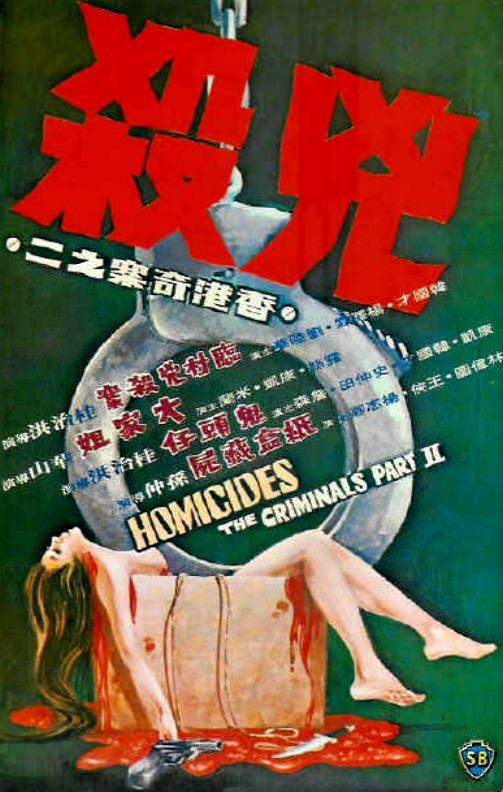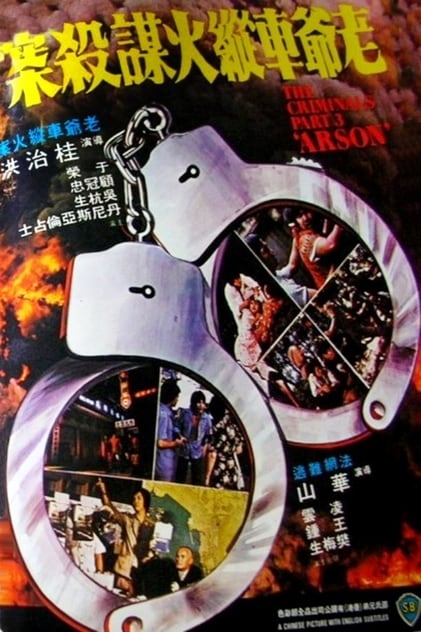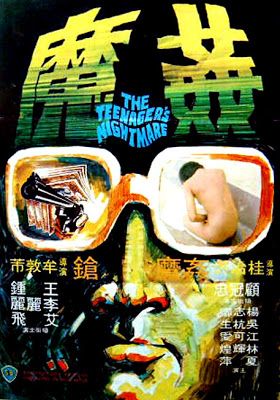 There’s something about a multi-part crime movie that compels. That was proven by PULP FICTION, certainly, and also THE CRIMINALS, a series of Shaw Brothers anthology films containing dramatizations of actual crimes. Whether THE CRIMINALS series, from 1976-77, inspired PULP FICTION, from 1994, is unknown, although the chances are good that they did, given that PULP’s writer-director is a well-known Shaw Brothers aficionado.
There’s something about a multi-part crime movie that compels. That was proven by PULP FICTION, certainly, and also THE CRIMINALS, a series of Shaw Brothers anthology films containing dramatizations of actual crimes. Whether THE CRIMINALS series, from 1976-77, inspired PULP FICTION, from 1994, is unknown, although the chances are good that they did, given that PULP’s writer-director is a well-known Shaw Brothers aficionado.
There’s something about a multi-part crime movie that compels.
Run Run and Runme Shaw, it seems, never found a genre they couldn’t exploit. The Shaws’ 300-plus title filmography encompassed musicals, eroticism, horror and, of course, martial arts action (or as we call them, “Kung Fu movies”). Crime seemed an obvious and inevitable addition, and while the five CRIMINALS films didn’t attain the same level of popularity as the Shaws’ erotic anthologies (FEARFUL INTERLUDE, LOVE SWINDLER, MOODS OF LOVE, etc.), which numbered in the dozens, or their even more numerous horror compilations (FEARFUL INTERLUDE, THE GHOST STORY, RETURN OF THE DEAD, HAUNTED TALES, ABENGERS FROM HELL, etc.), the crime themed Shaw Brothers features that followed in THE CRIMINALS’ wake (LOST SOULS, MURDERER PURSUES, MEN FROM THE GUTTER, etc.) showed that the genre had plenty of staying power.
It’s been claimed that most if not all of the Shaw Brothers anthology films were comprised of incomplete features (with aborted films being a common issue in the 1970s Shaw-verse). That would seem to explain the absence of framing segments in the CRIMINALS films, and the lack of any thematic continuity; you’ll be hard-pressed to find any link between the contents of these films outside the true crime signifier, and the fact that many of the same actors tend to turn up in different guises.
The CRIMINALS films, each segment of which had its own director and crew, are currently available only in cheap vcd format, meaning the image and sound quality leave much to be desired. This is a shame, as the films are notable for their sumptuous widescreen visuals and striking locations, chosen, supposedly, because they’re where the crimes being recreated actually occurred. Those crimes, incidentally, grow increasingly ugly as the series progresses, being emblematic of the gutter-level exploitation to which the Shaws’ films drifted in the late 1970s. Once Hong Kong cinema’s only game in town, in the seventies the Shaw Brothers found their primacy being challenged by the upstart Golden Harvest (headed by the former Shaw executives Raymond Chow and Leonard Ho). Desperation resulted, evident in the sleazy orientation of the CRIMINALS series, in which gratuitous nudity, brutality and rape were the norm.
…the films are notable for their sumptuous widescreen visuals and striking locations, chosen, supposedly, because they’re where the crimes being recreated actually occurred.
With that in mind, the series’ inaugural entry THE CRIMINALS / XIANG GANG QI AN (1976) seems rather tame. It features three segments, starting with “Hidden Torsos,” about a woman (Szu Shih) and her mute daughter murdered by the woman’s scumbag boyfriend (Wei Szu). It’s notable for the horror movie stylings of director Kang Cheng, a longtime Shaw helmer (of THE GOLD MEDALLIONS and KIDNAP) who adds a supernatural twist. It represents the closest the series ever came to the Italian giallo format.
segments, starting with “Hidden Torsos,” about a woman (Szu Shih) and her mute daughter murdered by the woman’s scumbag boyfriend (Wei Szu). It’s notable for the horror movie stylings of director Kang Cheng, a longtime Shaw helmer (of THE GOLD MEDALLIONS and KIDNAP) who adds a supernatural twist. It represents the closest the series ever came to the Italian giallo format.
Up next is “Valley of the Hanged” from Meng Hua Ho (who gave us nutzoid classics like THE OILY MANIAC and THE MIGHTY PEKING MAN). It may not be in the same league as “Hidden Torsos,” but it is diverting, being a rough and unflinching depiction of an island dweller (perennial Shaw Brothers heavy Ching Tien) who murders his unfaithful wife (Terry Liu) and her lovers before adding himself to the valley of the title.
Finally there’s “The Stuntman,” from INFRA-MAN’S Shan Hua. Set in a Hong Kong moviemaking milieu in which several recognizable Shaw stars play themselves, it features martial arts movie legend Lo Lieh as a movie stunt man attempting to pimp out a young woman (Tien Ni) who closely resembles a famous actress. This leads to gang warfare, jealousy and murder, and (of course) a great deal of sleazy sex and violence, two elements that would be ramped up considerably in the series’ subsequent installments.
 THE CRIMINALS PART 2: HOMICIDES/XIANG GANG QI AN 2: XIONG SHA (1976) contains four stories that are overall much darker and more exploitive than those of the previous film. Part one, “The Deaf Mute Killer,” which for some reason is exhibited in black and white, was directed by the demented Kuei Chih-Hung, whose other films include THE KILLER SNAKES and the unforgettable BOXER’S OMEN. Here he spins a suffocatingly bleak account of a deaf-mute played by Hon Kwok Choi (taunted in words the English subtitles render as “You damn dumb!”) who’s falsely accused of a rape and ends up murdering the actual guilty party, resulting in an extensive manhunt that our “hero” doesn’t survive. Kuei likewise directed the third story, “The Informer,” about a corrupt police informer (Ging-Man Fung) who steals a cop’s gun. The shortest of HOMICIDES’ segments, it’s also the least. Kuei’s major mistake, dramatically speaking, is one that would infect much of the rest of the series: the addition of a plodding police investigation intercut with the doings of the criminals, which lessens the excitement considerably.
THE CRIMINALS PART 2: HOMICIDES/XIANG GANG QI AN 2: XIONG SHA (1976) contains four stories that are overall much darker and more exploitive than those of the previous film. Part one, “The Deaf Mute Killer,” which for some reason is exhibited in black and white, was directed by the demented Kuei Chih-Hung, whose other films include THE KILLER SNAKES and the unforgettable BOXER’S OMEN. Here he spins a suffocatingly bleak account of a deaf-mute played by Hon Kwok Choi (taunted in words the English subtitles render as “You damn dumb!”) who’s falsely accused of a rape and ends up murdering the actual guilty party, resulting in an extensive manhunt that our “hero” doesn’t survive. Kuei likewise directed the third story, “The Informer,” about a corrupt police informer (Ging-Man Fung) who steals a cop’s gun. The shortest of HOMICIDES’ segments, it’s also the least. Kuei’s major mistake, dramatically speaking, is one that would infect much of the rest of the series: the addition of a plodding police investigation intercut with the doings of the criminals, which lessens the excitement considerably.
Far stronger is “Mama-San.” Directed by the returning Hua Shan, it’s an especially lurid number involving a depraved madam (a lip-smacking turn by Rosie, a.k.a. Rose Cheng) who subjects her underlings to a smorgasbord of depravity that includes sexual exploitation, brutality and murder. This segment comes complete with some elaborate martial arts fight scenes that remind us of the Shaw Brothers’ true filmic orientation, albeit with an unusual emphasis on physical pain.
The final segment is “Nude in A Box,” directed by Chung Sun (of LADY EXTERMINATOR), another nasty, sleaze-packed little film. It’s a courtroom drama pivoting on the discovery of a nude woman’s corpse packed into a shipping box. The culprit is a seemingly normal man who works for a shipping company, with the crime depicted in flashbacks that provide an uncomfortably graphic depiction of the killing of the woman, preceded by a protracted rape scene. A segment that’s alternately boring and deeply unpleasant, although pulled off with a sense of jittery hysteria unique to Hong Kong cinema.
the woman, preceded by a protracted rape scene. A segment that’s alternately boring and deeply unpleasant, although pulled off with a sense of jittery hysteria unique to Hong Kong cinema.
THE CRIMINALS PART 3: ARSON/XIANG GANG QI AN 3: LAO YE CHE ZONG HUO MOU SHA AN (1977) only has two segments. “Gun Snatchers” from (again) Hua Shan opens with a rooftop Karate fight, one of whose participants, an obese miscreant (Mei Sheng Fan, the “Fat Guy” in many Hong Kong exploiters, including the legendary RIKKI-OH), is arrested. Utilizing cunning and brute force, he manages to break free of police custody, an action he repeats continually with the help of a stolen pistol and his criminal syndicate pals. Ultimately, though, it’s the latter that do him in, in the form of a cannily placed undercover cop. Some impressive stunt work is evident in an elaborate foot chase through a crowded Hong Kong street in addition to the abovementioned karate showdown, but it’s a ho-hum segment overall, with, once again, far too much screen time expended on the police investigation.
In “Arson” Kuei Chih-Hung returns for another not-very-invigorating segment. It opens with a pair of miscreants setting a fire in a music parlor, resulting in a poorly filmed conflagration (visualized for some reason with the edges of the frame irised out) that kills five people and injures several more. The remainder of the episode consists of another protracted police investigation and subsequent trial. Kuei does what he can to maintain viewer interest, including a gratuitous knife fight and much kinetic editing, but it’s all for naught.
 After such an underwhelming entry it’s hardly surprising that the box office reportedly declined precipitously for THE CRIMINALS PART 4: ASSAULT/XIANG GANG AI AN 4: MIAO JIE HUANG HOU (1977), another two-parter. It begins with “Maniac,” once again helmed by Kuei Chih-Hung. The criminals this time around are a band of scumbags who subject young women to profoundly unpleasant bouts of sexual humiliation that nudge the proceedings into I SPIT ON YOUR GRAVE territory. But when the scumbags elect to do the same to the fashion designer love interest of one of the investigating officers (Shaw regular Hung Wei) their downfall is assured, in a bloody and intense hillside shoot-out.
After such an underwhelming entry it’s hardly surprising that the box office reportedly declined precipitously for THE CRIMINALS PART 4: ASSAULT/XIANG GANG AI AN 4: MIAO JIE HUANG HOU (1977), another two-parter. It begins with “Maniac,” once again helmed by Kuei Chih-Hung. The criminals this time around are a band of scumbags who subject young women to profoundly unpleasant bouts of sexual humiliation that nudge the proceedings into I SPIT ON YOUR GRAVE territory. But when the scumbags elect to do the same to the fashion designer love interest of one of the investigating officers (Shaw regular Hung Wei) their downfall is assured, in a bloody and intense hillside shoot-out.
For “Queen of Temple Street” Sun Chung returns as director. This segment harkens back to the first and second films, in that there’s no police investigation and the criminal is not a young punk but a middle aged gambler who, in order to pay off a gambling debt, sells his wife to a brothel for a year. There, after the poor woman undergoes all manner of degradation, her hubbie hits her up for more money and, when she turns down his request, sells her to the brothel for life. The woman’s upstanding brother turns up to try and help her out, but without success, leading to the most nihilistic conclusion of any CRIMINALS segment.
 THE CRIMINALS PART 5: THE TEENAGER’S NIGHTMARE/XIANG GANG QI AN 5: JIAN MO (1977) was the series’ final entry, and easily the most notorious of the bunch. It is, once again, a two-parter, with part one being the Tun-Fei Mou directed “Gun.” Mou is known for the unrelenting exploitation classics LOST SOULS and MEN BEHIND THE SUN, so you can be certain this mini-film pulls no punches. It features two miscreants (Chung Wang and Fei Ai) finding a machine gun and a couple of hand grenades, and, after blowing up a latrine with one of the grenades, embarking on a crime spree that includes threatening cops and holding up a bank. Inevitably, however, the law catches up with the miscreants and their lives go to Hell.
THE CRIMINALS PART 5: THE TEENAGER’S NIGHTMARE/XIANG GANG QI AN 5: JIAN MO (1977) was the series’ final entry, and easily the most notorious of the bunch. It is, once again, a two-parter, with part one being the Tun-Fei Mou directed “Gun.” Mou is known for the unrelenting exploitation classics LOST SOULS and MEN BEHIND THE SUN, so you can be certain this mini-film pulls no punches. It features two miscreants (Chung Wang and Fei Ai) finding a machine gun and a couple of hand grenades, and, after blowing up a latrine with one of the grenades, embarking on a crime spree that includes threatening cops and holding up a bank. Inevitably, however, the law catches up with the miscreants and their lives go to Hell.
“The Teenager’s Nightmare” was once again helmed by Kuei Chih-Hung. He provides a profoundly seedy number about a shade wearing rapist who targets teenage girls. The guy became deranged, we learn, because of his bitchy mother and sister, and now he can’t help but stalk and abuse virginal young ladies in a public shower. The proceedings aren’t quite as nasty as the film’s reputation led me to believe (with all the rapes taking place off-screen), but the film does nonetheless contain some truly winsome scenes, situated in an unspeakably grungy urban milieu, that show just how far the once respectable Shaws had devolved. The film might be some kind of trash classic if only it weren’t so obnoxiously dated: the electronic score is a constant distraction, as are the outrageously seventies-centric fashions and dumb-assed attempts at comic relief. The same, of course, can be said for all these films, but those issues are especially grievous here.
